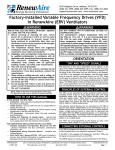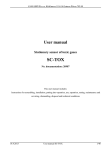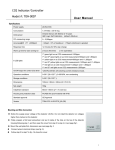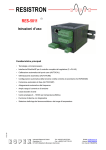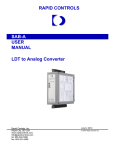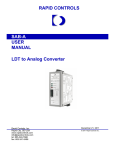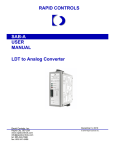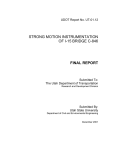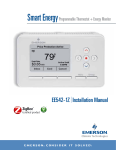Download cerv wireless touchscreen controller user`s manual
Transcript
USER’S MANUAL CERV WIRELESS TOUCHSCREEN CONTROLLER USER’S MANUAL REVISION 1.3 BUILD EQUINOX 1103 N. HIGH CROSS RD. URBANA, IL 61802 1-773-492-1893 1 CONTROLLER OVERVIEW The CERV’s wireless communication touchscreen controller literally puts control of your indoor air quality directly in your hands. This touchscreen is your gateway to interacting with the most advanced indoor air quality system available today. The CERV’s touchscreen interface is designed to be, easy to read and intuitive. You can view real time air quality and comfort conditions in your home, and configure CERV settings and auxiliary devices. This guide serves as a reference to allow you to maximize your understanding of how to configure the CERV to serve you best. Refer to the CERV Operation Manual for more information on the CERV’s system components and modes of operation. The touchscreen controller communicates wirelessly with the CERV, and requires plugging into a power outlet. All of the system’s sensors are located within the CERV, so the touchscreen can be placed where most convenient. The controller can be placed on a flat surface or mounted to a wall using the bracket attached to the back of the controller enclosure. CERV setpoints and configurations are stored locally on the CERV’s control board memory, so powering the touchscreen is not necessary for the CERV to operate. Checking CERV status or making any changes requires use of the touchscreen or online at http://buildequinox.com/products/cerv/cerv-ice/ if the CERV-ICE gateway has been purchased. To use the touchscreen controller, make sure that both the touchscreen and CERV are powered. There should be a green wireless signal in the upper right corner of the screen if the wireless touchscreen controller is properly connected to the CERV. If this wireless symbol is gray with a red X there is a communication problem. Check power to the CERV, if OK, the touchscreen may be out of range and need to be moved closer to the CERV. 2 Contents Home Screen 4 Heating and Cooling Setpoints 5 CO2/VOC and Ventilation Setpoints 6 Recirculation Setpoint 7 Trigger Ventilation 8 Wireless Ventilation Switch Setup 9 Auxiliary Device Setup 10 Auxiliary Device – Geo-Boost Setup 11 Auxiliary Device – Zone Setup 12 Auxiliary Device – External System Control Setup 13 CERV Operation Mode 14 Assessment Interval 15 Display Settings 16 Status and Alerts 17 3 HOME SCREEN OVERVIEW: The Home Screen displays the current temperature, relative humidity, VOC, CO2, and status of the CERV. It additionally provides quick access to other screens, such as heating and cooling setpoints, timed ventilation, status and alerts, and the Main Menu. The background color of the screen, along with some of the icons, will change depending on the CERV’s current operating mode. The possible modes are: Assess – Gray screen. The CERV is recirculating air throughout the house in order to obtain current readings of the home’s overall health and comfort. When the CERV is within all setpoints and does not need to ventilate, nor heat or cool, it will revert to its standby off mode. It will do an Assess for 2 minutes every so often depending on the Assessment Interval that has been set. Vent (Heat/Cool/Setpt) – The CERV will ventilate the home for various reasons. The CO2/VOC levels may have gone above setpoint, a wireless ventilation switch may have been triggered, a timed ventilation event may have been started, or the CERV may have decided that it is more efficient to heat or cool the home with outside air. If the home is within the heating and cooling setpoints, but the CERV is ventilating, the screen will be green and the current Mode will show Vent Setpt. A red or blue screen will appear if the CERV is heating or cooling while in ventilation mode. Recirc (Heat/Cool) – If the fresh air requirement is satisfied, but the inside temperature is outside the bounds of your heating or cooling setpoint, the CERV will go into a recirculation heating or cooling mode. The screen will be red or blue depending on heating or cooling mode. Off – The CERV has determined that your air quality is acceptable and your inside temperature is satisfactory. It will conserve energy by turning itself off. The screen will be gray while in this standby mode. The CERV fans will come on to do an Assess after a period of time, while in Off Mode. The period of time between assessments will depend on the Assessment Interval setting. Other Notes: The colored bars below the CO2/VOC readings indicate how the current air quality levels are compared to the setpoint. Green indicates that your air quality is acceptable, yellow indicates that the pollutant level is nearing the ventilation setpoint, and orange indicates that the pollutant level is above the setpoint (the CERV be ventilating or start doing so shortly). 4 HEATING AND COOLING SETPOINTS OVERVIEW: On this screen, you may configure your heating and cooling setpoints for the CERV. There are two paths to get to the heating and cooling setpoint screen. From the Home Screen, either press the thermometer icon or go through the Main Menu. On the temperature setpoints screen you can change the high and low temperature setpoints, and then press the checkmark to accept the change. To reject, changes or make no change, press the X. Pressing either the checkmark or the X will take you to the previous screen. Note: The lower bound of the cooling setpoint is two degrees F above the current heating setpoint. Likewise the heating setpoint cannot be set higher than two degrees F lower than the current cooling setpoint. It may be necessary to move one setting first in order to move the other. On many screens you will notice a “?” button. Pressing this button will take you to a Help Screen for the screen you are currently on. The Help Screen provides detailed information on the current screen including what settings can be changed and how these settings relate to the CERV’s operation. Below is the help screen for the Temperature Setpoint screen. This demonstrates how the CERV operates in heating or cooling mode in relation to the setpoints. 5 CO2/VOC AND VENTILATION SETPOINTS OVERVIEW: Ventilation setpoints for the CERV are configured on this screen. There are two paths that take you to the Ventilation Setpoints. Either press the region by the CO2 and VOC symbols, or go through the main menu path as shown below. Once there, the left of the screen are the CO2 and VOC sensor settings. The CERV is a DCV or “Demand Controlled Ventilation” system and has independent CO2 and VOC sensors. These sensors are controlled with the same setpoint. If the sensors read a CO2 or VOC level above the pollutant PPM (parts per million) concentration setpoint, the CERV begins its fresh air ventilation mode to bring the air quality back to an acceptable level. Clicking on the CO2 or VOC buttons at the top will disable or re-enable either sensor. A red line on the button indicates the sensor is enabled. The right side of the screen allows you to set scheduled ventilation in addition to active DCV, where the CERV ventilates for the chosen % out of an hour regardless of the CO2 and VOC sensor readings. This can be used if extra ventilation is desired on top of the sensor driven demand controlled ventilation. For the most energy efficient CERV operation, set the scheduled ventilation to 0% and only use DCV operation. RECOMMENDATIONS: Our recommended Ventilation Setpoint is 900 to 1100PPM. Studies have shown that levels above 1000PPM indicates that a home may have detectable odors as well as negative effects on human productivity, alertness, and general comfort. In some rare cases, outside air may temporarily be more polluted than the air inside your home. In this case, bringing in outside air will increase the pollution level inside, rather than decrease it. This could be due to neighbors burning leaves, wood burning stoves, etc. In this type of situation, you may choose to disable the CERV’s the affected CO2 or VOC sensor as discussed earlier (note: the VOC sensor is usually the one most affected by smoke and combustion fumes). 6 RECIRCULATION OVERVIEW: Scheduled Recirculation can be used to move air throughout the home during times when the CERV would otherwise be off because no heating, cooling, or ventilation is needed. This Scheduled Recirculation setting is reached through the Comfort Menu. By setting the Scheduled Recirculation setpoint, the CERV will spend the set % of the Assessment Interval time in Recirculation Mode. For example, if the Assessment Interval is set to 10 minutes and the Scheduled Recirculation set to 10%, the CERV will recirculate for 1 minute out of the 10 minute interval. During recirculation, only the inside supply fan is powered. RECOMMENDATIONS: In general, we often recommend that Scheduled Recirculation be initially configured to 0%, so that you can get a feel for the comfort level throughout your house. If you notice temperature differences around the house, but the CERV is within the temperature setpoints and in Off Mode, recirculation can help to even out these temperature differences. Note that adjusting the temperature setpoints may also be needed. 7 TRIGGER VENTILATION OVERVIEW: From the Home Screen or through the Comfort Menu you can trigger a timed fresh air ventilation event. Triggering Ventilation immediately switches the CERV into fresh air ventilation mode for a specified amount of time. Use this function when you are cooking or have another event that may produce moisture or odors that will require ventilation.. Even though the CERV will detect the pollution and ventilate automatically, there can be a delay between the production of the pollution and when the CERV detects it. Proactively ventilating can help mitigate propogation of pollution in the home. To use the function, change the time to the desired length and then press Start Vent. The CERV will go to vent mode and the time remaining will begin counting down. If you would like to cancel the ventilation at anytime, press the stop button. 8 WIRELESS VENTILATION SWITCH SETUP OVERVIEW: If you purchased the CERV wireless switch option, you will need to enable this option on the controller and then configure the ventilation event length for when the switch is activated. This is done through the CERV Settings Menu. Your configuration may vary depending on whether you are using the battery-free wireless rocker switches (PTM265) or the active circuit transmitter (ERM-DAC) wired in-line with an existing wall switch or other circuit. For the wall switch, the CERV will vent when the switch is pressed for the set event length before resuming normal operation. The active circuit transmitter operates a little differently. When the circuit connected to the circuit transmitter is turned on, the CERV will begin to ventilate. When the circuit is turned off, the CERV will continue to ventilate for the set event time length before resuming operation. 9 AUXILIARY DEVICE SETUP OVERVIEW: Several auxiliary device options can be purchased to use with the CERV. When enabled on the controller, these devices are controlled through either a wired connection or wirelessly. Available auxiliary device choices are listed below. See the individual product brochures for more information on each auxiliary device option. N/A – No auxiliary device is attached to the CERV. Geo-Boost ground loop heat exchanger – Enables the CERV to act as a hybrid air/ground source heat pump by using the sub-surface ground temperature to pre-heat or pre-cool the incoming fresh air when beneficial. Zone System – Through the use of the CERV’s Zone damper system, the CERV is able to manage the air (both air quality and temperature) in two independent zones. External System Control - Build Equinox’s Hydro-EX heat exchanger adds supplemental hydronic post-heating and/or post-cooling to the system. Backup electrical duct heating and supplemental ventilation may also be controlled through this auxiliary type. Please see the following sections for more information on setup and configuration of your auxiliary device. 10 AUXILIARY DEVICE – GEO-BOOST SETUP OVERVIEW: Geo-Boost converts the CERV into a hybrid geothermal-air source heat pump, increasing both heating and cooling capacities and efficiencies. The Geo-Boost unit is connected to a geothermal loop to make use of steady ground temperatures, which allows the incoming fresh air to be either pre-heated or cooled before going to the CERV. The CERV is able to intelligently determine when the Geo-Boost provides beneficial heating or cooling to the system through the use of its internal sensors and algorithms. This is done by the CERV, so no external inputs from the user are necessary. Once the Geo-Boost option has been enabled it will operate automatically. See the Geo-Boost product brochure and manual for more information and installation instructions. RECOMMENDATIONS: No Configuration is needed for this Auxiliary Device. 11 AUXILIARY DEVICE – ZONE SETUP OVERVIEW: Through the use of the CERV’s optional Zone damper system, the CERV gains the capability to independently managing air quality and temperature in two separate zones. The CERV will spend a period of time (based on the Cycle Length and Zone Balance parameters) on one zone, then switch to the other for the remainder of time. An indicator of the active zone can be seen from the home screen’s status. RECOMMENDATIONS: These parameters will generally be configured to the size of the zones being managed. For example, if the first zone is 1000 sq ft, and the second zone is 500 sq ft, it may be reasonable to set the Zone Balance parameter to 60% or 70% (1000/1500). If one zone continuously operates in fresh air vent mode during its active period while the other zone operates in recirculation or off modes, the time period for the zone continuously operating in fresh air mode can be increased. A typical Cycle Length setting may be 1 hour, but this may be changed depending on the occupants comfort. See the Zone damper manual for more information. 12 AUXILIARY DEVICE – EXTERNAL SYSTEM CONTROL SETUP OVERVIEW: External System Control can be used in conjunction with a Hydro-EX to provide additional conditioning, back up electrical duct heating, or with a supplemental ventilation system to provide fresh air. The Build Equinox Hydro-EX heat exchanger provides additional post-heating and/or post-cooling to the CERV through a liquid heat-exchange loop. The system can be configured for heating, cooling, or both heating and cooling. Once the system types are selected, and the confirm button pressed, you will be taken through screens to configure the “Setpoint Offset”. The Setpoint Offset configures the CERV to enable the selected device relative to the main air quality, heating, or cooling setpoints. An offset of 0 would activate the device using the main CERV setpoints. For example, if your heating setpoint is 75 F, and you have a Hydro-EX configured as a post-heater mainly for backup purposes, you could set the heating setpoint offset to -10 degrees. This would mean that at inside temperatures above 65 F(75-10), the Hydro-EX would be disabled, but once the inside temperature dropped below 65 F, the Hydro-EX would be enabled whenever the CERV is heating. The configuration screen shows the setpoint at which the device will be activated relative to your chosen offset and where your current main setpoints are set. Changing the main system setpoints will not change the offset, however, external device setpoint will change accordingly. RECOMMENDATIONS: In general, for Hydro-EX post heating/post cooling, we recommend an offset of 0 F. This would mean that if you have a device configured for heating, the device would be enabled any time the CERV sees that heating is needed, and similarly for cooling. 13 CERV OPERATION MODE OVERVIEW: In most cases, you will want to let the CERV use its own internal algorithms to determine which mode is best, however there may be scenarios in which you may want to specify that the CERV only operates in ventilation mode, otherwise, the system should remain off. RECOMMENDATIONS: Unless you are positive that you need to switch the CERV out of Auto mode, we recommend that you do not change this. The CERV’s recirculation mode (which does not occur in Vent Only mode) is a very important part of its operation, and helps to distribute air around the house to keep your air quality and temperatures uniform. 14 CERV ASSESSMENT INTERVAL OVERVIEW: Whenever heating, cooling, and ventilation setpoints are all satisfied, the CERV will normally turn off to save energy (or recirculate air, if you have configured that parameter). By default, the CERV is set to an Assessment Interval of 10 minutes, which means that after 10 minutes of the CERV being off, the CERV will perform an assessment to see if any heating, cooling, or ventilation adjustment is needed. If you would like the CERV to remain off for longer periods of time between assessments, this value can be increased up to a maximum of 120 minutes. RECOMMENDATIONS: In general, it is recommended to leave the assessment interval at 10 minutes, as this allows the CERV to frequently update its temperature/indoor air quality sensors and catch any pollution events quickly. Some users may expand this assessment to a longer time period if they feel they would like to reduce the noise of the fans turning on; just be aware that the CERV may not be quite as responsive to indoor air quality pollution events under increased assessment interval time. 15 DISPLAY SETTINGS OVERVIEW: On the Display Settings screen, you can configure the auto-off feature of the screen. If there has been no interaction with the screen after the amount of time specified in Display Timeout, the touchscreen controller will disable the screen to save power. Simply touch the screen again to turn the display back on. Disabling the auto off feature will turn the screen on indefinitely. 16 STATUS & ALERTS OVERVIEW: The Status & Alerts screen provides descriptions of the icons displayed in the Status & Alerts bar on the Home Screen. Clicking on the status bar in the upper right of the Home Screen takes you to the Status & Alerts Screen; likewise you can get there through the Main Menu. There is always a connection icon in the status bar indicating the status of the connection between the CERV and the touchscreen controller. Any additional icons in the status bar indicate different events that may be occurring. If the CERV detects that there is a problem with the system, such as a malfunctioning sensor, an error symbol icon will appear in the status bar. On the Status & Alerts screen an error reference code will be displayed on the line with the yellow warning symbol. This will aid us in determining exactly what is wrong with the system and what repair if any may be necessary. In most cases the error will fix itself or can be fixed by resetting power to the CERV. 17

















